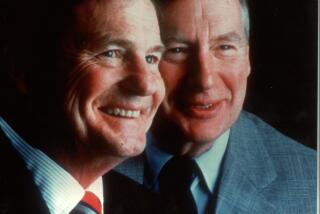Cameras in the Desert
- Share via
The blue plastic bubbles atop Saudi Arabia’s Dhahran International Hotel symbolize all that has changed in TV’s coverage of war.
The bubbles house satellite uplink facilities, and they now transmit reports on U.S. and other troops training for a possible war with Iraq. Should that war begin, the uplinks would transmit TV’s taped combat coverage--faster and in greater quantities than ever before in a large-scale conflict.
And that coverage, for the first time, would be watched on both sides of the battlefront: Cable News Network’s coverage of U.S. and allied troops can be seen on a same-day basis both in Baghdad and in Washington.
How much will be seen is anyone’s guess, even though Pentagon officials say there’ll be no censorship at the transmission site in Dhahran. Because for all the new and flashy technology, at least one thing is expected to remain the same in the event of a Persian Gulf war--the friction between the military and the media.
If fighting erupts, ABC anchorman Peter Jennings thinks U.S. military officials “will prevent us from seeing it as best they can,” although he admits that he doesn’t know what really will happen if the shooting starts:
“I don’t know what the bottom line is... but it’s an extremely simple environment in which to control the press.”
Although details still are being worked out, there initially would be print and broadcast pool coverage of any hostilities, with a “security review” of outgoing material to see if it violates ground rules of coverage.
Even though the Pentagon says there’ll be no censorship, it’s unclear what will happen if the security review causes a dispute over a given report and what, if anything, will happen to the reporter if the story is sent.
“If you agree to the ground rules, you would not expect, if you violate them, to have access to the U.S. military resources,” says Robert Hall, a senior Pentagon spokesman.
Hall refuses to specifically say if a violator would be barred from accompanying U.S. troops, but “we are confident that there is not a problem with reporters understanding what the purpose of the ground rules is.”
“We are not going to let people compromise the safety of the troops,” he says. “That’s the bottom line. I can’t speculate on what would happen if people did. But we are not going to allow that.”
Print and TV reporters in Vietnam, while also subject to ground rules regarding tactical information, such as planned operations, had a great deal of access to U.S. operations. American viewers saw an uncensored war.
But fast TV coverage wasn’t common. Satellite transmission was in its infancy and rarely used because of cost. Field reports--on film then, not videotape--usually aired several days after the fact.
But satellites got a heavy workout 23 years ago this month as U.S. networks showed the bloody scenes of the communist Tet offensive in Vietnam. NBC showed the first footage, shots of fighting at the U.S. Embassy in Saigon, airing it raw and unedited on “The Huntley-Brinkley Report.”
Even with satellites, NBC’s footage was almost a day old. It had to be flown from Saigon to Tokyo, processed there, and then sent via satellite to the United States. It arrived 10 minutes before the show began at 6:30 p.m. EST.
Despite today’s swift TV coverage, network officials say that if war starts after Tuesday’s deadline the United Nations has given Irag to get out of Kuwait, it’s unlikely there’d be live battlefield coverage.
The uplink gear isn’t mobile enough. It also can make a nice target.
“You never say never in this business,” says Ed Turner, CNN’s executive vice president for news-gathering. “But it (live coverage) is highly unlikely at this point because the gear, while portable, ain’t that portable.
“You still need to set up an uplink and it takes a couple of hours to assemble. And if you’re out where shells are falling. .. .”
Print and broadcast reporters must sign up in Dhahran, in the same hotel where the TV satellite farm is located, at the Joint Information Bureau--nicknamed “The Jib.” The bureau’s director is U.S. Army Col. William Mulvey.
The number of print and broadcast journalists registered there fluctuates daily, but it has almost grown to Vietnam size: 450, when President Bush visited U.S. troops at Thankgiving; nearly 360 later in December. Of that total, 110 were from ABC, CBS, CNN and NBC.
Although there’s no censorship, reporters must abide by military ground rules concerning tactical operations, unit locations and strength.
And Mulvey says he has warned potential pool reporters that he won’t let anyone go out with the troops “who’s not in good physical condition.
More to Read
Sign up for Essential California
The most important California stories and recommendations in your inbox every morning.
You may occasionally receive promotional content from the Los Angeles Times.













